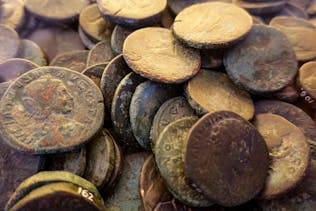3 Lessons from Ancient Rome’s 3rd Century Inflation Crisis
Submitted by Concierge Financial Planning, LLC on May 22nd, 2022
 Inflation. At time of writing the year over year figure is reported to be 8.3%. While (hopefully) not an unfamiliar concept to those planning for retirement, these days the word is on everybody’s tongue. Even for those who make the effort to avoid news, the county’s inflation issue announces itself everywhere in the form of rising prices. Only the most price-oblivious of shoppers could fail to notice, and even they may be induced to do a double take when they see their favorite products seemingly shrinking on the shelves. I’m not an economic expert so while I’ll spare you my hot take on the current situation, I will share an important historical observation. Inflation is nothing new. Inflation is a natural, and in fact inescapable, part of a monetary system. So, give the Fed (or is it Putin?) a break and cast your blame upon the Lydians, the ancient Anatolian people, who, in the 7th century BCE, became minters of the first known coinage.
Inflation. At time of writing the year over year figure is reported to be 8.3%. While (hopefully) not an unfamiliar concept to those planning for retirement, these days the word is on everybody’s tongue. Even for those who make the effort to avoid news, the county’s inflation issue announces itself everywhere in the form of rising prices. Only the most price-oblivious of shoppers could fail to notice, and even they may be induced to do a double take when they see their favorite products seemingly shrinking on the shelves. I’m not an economic expert so while I’ll spare you my hot take on the current situation, I will share an important historical observation. Inflation is nothing new. Inflation is a natural, and in fact inescapable, part of a monetary system. So, give the Fed (or is it Putin?) a break and cast your blame upon the Lydians, the ancient Anatolian people, who, in the 7th century BCE, became minters of the first known coinage.
Inflation has been with us a long time. Human beings, creative as we are, dealt with it in a variety of ways across the long millennia since those gleaming clumps of metal currency were first struck. Certainly, no discussion of inflation throughout history is complete without reference to the monetary crisis that afflicted Rome beginning in the 3rd century CE, and no discussion of The United States’ place in history is complete without seizing every opportunity to compare the nation to Rome – hubristic yet irresistible attempts to cast ourselves in the mold of one of history’s most lauded societies. Alike or not, the entire Mediterranean world suffered immense economic hardship throughout the 3rd century as decades of debasement of Roman currency sent prices soaring. Disease, war, and political instability (sound familiar?) created a situation in which state revenues dwindled while expenses climbed. Those wealthy enough to be in possession of land and bullion were able to weather the tumultuous period with relative ease, while those less fortunate members of the ancient middle class: merchants, craftspeople, and small independent farmers had their meager wealth erased. This crunch continued unabated, and its consequences compounded, for more than one hundred years until the monetary reforms of Diocletian and Constantine restored public faith in Roman currency. While there are countless dusty tomes filled with analyses of this period and its consequences, I think we can draw a few relatively simple lessons from Rome’s great financial crisis.
- When it comes to inflation, not all assets depreciate in the same way. Those families who had been able to thrive despite two centuries of inflationary squeeze were those who held on to real estate and commodities. Over the long haul, families who hunkered down and retained their land and stores of gold and silver (usually in the form of old, pre-debasement coins) weathered the unstable economic climate better than those who couldn’t or didn’t. Real estate remains strong in the face of inflation, with homeowners much less vulnerable to currencies loss of value than renters. Conversely commodities today no longer work quite so well as an inflation hedge. They’re extremely volatile and their risk adjusted return over time is low compared with today’s alternatives; Inflation linked treasury bonds and stocks should be a part of every retiree portfolio. In fact, Series I inflation linked savings bonds are currently paying 9.62%. Have you purchased your annual allotment of $10,000 per person?
- The heightened instability that normally accompanies high inflation encouraged many Romans to rethink their relationship to money and other means of wealth generation. Though it may be tempting to look back on smallholders who, amidst the crisis, felt forced to sell their holdings on to larger estates as victims, it is likely many would have willingly opted to do so as a means of mitigating risk and reducing their exposure to the rampant economic volatility. During the crisis the loss of just a single harvest could be devastating. Under these circumstances, it becomes clear why so many decided to sell their plots to large estates, where they would continue to live and work in exchange for a smaller, but more reliable, share of the profits. They certainly would not have viewed their choice in these terms, but these Roman farmers were doing much the same as we do today when making more conservative financial decisions such as paying down debt, keeping a larger cash position, and investing in short term, floating rate and inflation linked debt. Ideally, these Romans would have already allocated their assets based on their own tolerance for risk and individual goals, but I’ve yet to come across any reference to financial planners in the sources.
- Though inflation is generally perceived to be entirely negative, there can be a silver lining. Inflation, when the value of money is in flux, creates novel opportunities for real price discovery and allows for a renegotiation of the cost of goods and labor. At the close of the 3rd century, the emperor Diocletian sought to control this process with his infamous “Edict on Maximum Prices”. While an earnest attempt to protect consumers and curb unscrupulous profiteering, the edict tipped the scale too far in the other direction and would have forced farmers and other producers to sell their goods at a loss had they obeyed the letter of the law. As such, the edict was almost entirely ignored, demonstrating the limits of Roman economic understanding, and leaving a stain on Diocletian’s otherwise remarkably prescient financial policies. We are witnessing this in our own time in the form of the “great resignation”, wherein employers scramble to hike wages as little as possible in order retain their workforce (or expand their hiring pool to minors) while workers quit in droves to seek higher wages elsewhere. A similar process unfolds on store shelves, where the size and quantity of many goods has been reduced while prices climb. Here the negotiation between corporate profits and consumers will ideally yield fair valuation of goods, just as the ebb and flow of workers will ideally result in fairer valuation of labor.
This has all happened before and will happen again. We can, however, learn from the past and prepare ourselves better. Today we benefit from access to considerably more monetary knowledge and expertise which allows both the Fed and financially savvy individuals to act quickly to adapt, to reduce inflation, and hopefully correct and normalize the economy in a couple of years as opposed to a couple of centuries.

